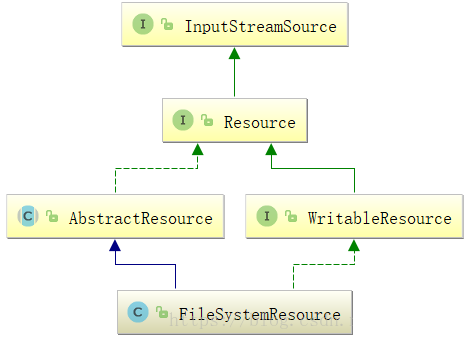BeanDefinition的Resource定位
IOC容器初始化过程概述
IOC容器初始化是由上文提到的refresh()方法来启动的,这个方法标志着IOC容器正式启动。
IOC容器初始化过程分为三个过程:
BeanDefinition的Resource定位过程。
这个Resource定位是指BeanDefinition资源定位,它由ResourceLoader通过统一的Resource接口完成。这个定位过程就是容器寻找数据的过程,就像水桶要装水首先需要找到水一样。
BeanDefinition的载入和解析过程。
这个过程就是根据上一步定位的Resource资源文件,把用户定义好的Bean表示成IOC容器内部的BeanDefinition数据结构。BeanDefinition实际就是POJO对象在IOC容器中的抽象,通过BeanDefinition定义数据结构,使IOC容器能够方便地对POJO对象也就是Bean进行管理。
向IOC容器注册BeanDefinition的过程。
这个过程是通过调用BeanDefinitionRegistry接口的实现来完成的,把载入过程生成的BeanDefinition向IOC容器注册。最终在IOC容器内部将BeanDefinition注入到一个HashMap中,IOC容器就是通过这个HashMap来持有这些BeanDefinition数据的。
注意: 这里需要注意的是,上面谈到的只是IOC容器的初始化过程,这个过程一般不包含Bean依赖注入的实现。Bean的定义和依赖注入是两个独立的过程。依赖注入一般发生在第一次getBean()向容器索要Bean的时候,但是如果配置了lazyinit,则初始化的时候这样的Bean已经触发了依赖注入。
这里先分析IOC容器的第一个过程,BeanDefinition的Resource定位过程。
BeanDefinition的Resource定位过程
一般我们通常使用的IOC容器有FileSystemXmlApplicationContext、ClassPathXmlApplicationContext、XmlWebApplicationContext、WebApplicationContext、AnnotationConfigApplicationContext等。
注解方式AnnotationConfigApplicationContext前置读取资源跟Xml方式容器有区别,注解方式AnnotationConfigApplicationContext是读取指定扫描包下的.class,组装成元数据,然后解析每个类,判断是否有@Component注解(@Service含@Component注解)进行BeanDefinition数据结构读取, Xml方式则是解析Spring配置的applicationContext.xml的文件,读取BeanDefinition数据结构,但是最后都走AbstractApplicationContext#refresh()模板方法,理解了Xml实现方式容器的核心,注解方式就比较好理解。
因为Xml实现方式理解IOC容器会更直观些,以Xml方式实现进行IOC容器源码解读。下面以FileSystemXmlApplicationContext为例,分析Resource的定位过程。
FileSystemXmlApplicationContext应用:
// 根据配置文件创建IOC容器
ApplicationContext context =
new FileSystemXmlApplicationContext("classpath:applicationContext.xml");
// 从容器中获取Bean
ConferenceServiceImpl conferenceService = (ConferenceServiceImpl)context.getBean("conferenceService");
// 调用Bean方法
conferenceService.conference();

"实线"代表extends,"虚线"代表implements。从类图可以看到继承了ApplicationContext,而ApplicationContext
又继承了BeanFactory,所以FileSystemXmlApplicationContext具备了IOC的基本规范和一些高级特性。
在类图的最右上方可以看到继承了ResourceLoader,用以读入以Resource定义的BeanDefinition的能力。
FileSystemXmlApplicationContext源码:
package org.springframework.context.support;
import org.springframework.beans.BeansException;
import org.springframework.context.ApplicationContext;
import org.springframework.core.io.FileSystemResource;
import org.springframework.core.io.Resource;
public class FileSystemXmlApplicationContext extends AbstractXmlApplicationContext {
public FileSystemXmlApplicationContext() {
}
public FileSystemXmlApplicationContext(ApplicationContext parent) {
super(parent);
}
/**
* 根据用户定义的Bean XML文件路径,载入BeanDefinition,自动创建IOC容器
*/
public FileSystemXmlApplicationContext(String configLocation) throws BeansException {
this(new String[] {configLocation}, true, null);
}
/**
* 根据用户定义的多个Bean XML文件路径,载入BeanDefinition,自动创建IOC容器
*/
public FileSystemXmlApplicationContext(String... configLocations) throws BeansException {
this(configLocations, true, null);
}
/**
* 根据用户定义的多个Bean XML文件路径,载入BeanDefinition,自动创建IOC容器,允许指定自己的双亲IOC容器
*/
public FileSystemXmlApplicationContext(String[] configLocations, ApplicationContext parent) throws BeansException {
this(configLocations, true, parent);
}
/**
* 是否允许自动刷新上下文
*/
public FileSystemXmlApplicationContext(String[] configLocations, boolean refresh) throws BeansException {
this(configLocations, refresh, null);
}
/**
* 在对象初始化的过程中,调用refresh()方法启动载入BeanDefinition过程
*/
public FileSystemXmlApplicationContext(String[] configLocations, boolean refresh, ApplicationContext parent)
throws BeansException {
super(parent);
setConfigLocations(configLocations);
if (refresh) {
refresh();
}
}
/**
* 根据用户的xml构建Resource对象,这是一个模板方法,
* 在BeanDefinitionReader的loadBeanDefinition()方法中被调用。
*/
@Override
protected Resource getResourceByPath(String path) {
if (path != null && path.startsWith("/")) {
path = path.substring(1);
}
return new FileSystemResource(path);
}
}
FileSystemXmlApplicationContext中有很多构造函数,实现了对参数configLocation进行处理,以XML文件方式
存在的BeanDefinition能够得到有效处理。比如,实现了getResourceByPath()方法,这个是一个模板方法,是为
读取Resource服务的。在初始化FileSystemXmlApplicationContext的过程中,通过refresh()来启动整个调用,
进入AbstractApplicationContext的refresh()方法。
@Override
public void refresh() throws BeansException, IllegalStateException {
synchronized (this.startupShutdownMonitor) {
// Prepare this context for refreshing.
// 调用容器准备刷新的方法,设置容器的启动时间为当前时间,容器关闭状态为false,同时给容器设置同步标识
prepareRefresh();
// Tell the subclass to refresh the internal bean factory.
// 告诉子类启动refreshBeanFactory()方法,
// Bean定义资源文件的载入从子类的refreshBeanFactory()方法启动[***重点***]
ConfigurableListableBeanFactory beanFactory = obtainFreshBeanFactory();
// Prepare the bean factory for use in this context.
// 为BeanFactory配置容器特性,例如类加载器、事件处理器等
prepareBeanFactory(beanFactory);
try {
// Allows post-processing of the bean factory in context subclasses.
// 为容器的某些子类指定特殊的BeanPost事件处理器,进行后置处理
postProcessBeanFactory(beanFactory);
// Invoke factory processors registered as beans in the context.
// 调用BeanFactory的后置处理器,这些后置处理器是在Bean定义中向容器注册的
invokeBeanFactoryPostProcessors(beanFactory);
// Register bean processors that intercept bean creation.
// 为BeanFactory注册BeanPost事件处理器,BeanPostProcessor是Bean后置处理器,用于监听容器触发的事件
registerBeanPostProcessors(beanFactory);
// Initialize message source for this context.
// 初始化信息源,和国际化相关
initMessageSource();
// Initialize event multicaster for this context.
// 初始化容器事件传播器
initApplicationEventMulticaster();
// Initialize other special beans in specific context subclasses.
// 调用子类的某些特殊Bean初始化方法
onRefresh();
// Check for listener beans and register them.
// 检查监听Bean并且将这些Bean向容器注册
registerListeners();
// Instantiate all remaining (non-lazy-init) singletons.
// 初始化所有剩余的(non-lazy-init)单态Bean
finishBeanFactoryInitialization(beanFactory);
// Last step: publish corresponding event.
// 初始化容器的生命周期事件处理器,并发布容器的生命周期事件,结束refresh过程
finishRefresh();
}
catch (BeansException ex) {
if (logger.isWarnEnabled()) {
logger.warn("Exception encountered during context initialization - " +
"cancelling refresh attempt: " + ex);
}
// Destroy already created singletons to avoid dangling resources.
destroyBeans();
// Reset 'active' flag.
cancelRefresh(ex);
// Propagate exception to caller.
throw ex;
}
finally {
// Reset common introspection caches in Spring's core, since we
// might not ever need metadata for singleton beans anymore...
resetCommonCaches();
}
}
}
上面refresh()方法的源码,是整个IOC容器初始化的过程。咱们这里讨论的是BeanDefinition的Resource资源的定位,
重点关注refresh()方法中的obtainFreshBeanFactory()方法,该方法也位于AbstractApplicationContext类中。
protected ConfigurableListableBeanFactory obtainFreshBeanFactory() {
refreshBeanFactory();
//getBeanFactory获取的bean工厂将在refreshBeanFactory初始话
return getBeanFactory();
}
在上面的obtainFreshBeanFactory()方法中可以看到refreshBeanFactory()方法,是AbstractApplicationContext中的一个抽象方法,委托给子类具体实现
方法的具体实现在AbstractRefreshableApplicationContext中。
@Override
protected final void refreshBeanFactory() throws BeansException {
// 判断如果已经建立了BeanFactory,则销毁并关闭BeanFactory
if (hasBeanFactory()) {
destroyBeans();
closeBeanFactory();
}
try {
// 创建IoC容器,这里使用的是DefaultListableBeanFactory
DefaultListableBeanFactory beanFactory = createBeanFactory();
// 对IoC容器进行定制化,如设置启动参数,开启注解的自动装配等
beanFactory.setSerializationId(getId());
customizeBeanFactory(beanFactory);
/**
* 启动对BeanDefinition的载入,这里使用了一个委派模式,
* 在当前类中只定义了抽象的loadBeanDefinitions方法,具体的实现调用子类容器
*/
loadBeanDefinitions(beanFactory);
//这里就是getBeanFactory赋值的地方
this.beanFactory = beanFactory;
}
catch (IOException ex) {
throw new ApplicationContextException("I/O error parsing bean definition source for " + getDisplayName(), ex);
}
}
在refreshBeanFactory()方法中,可以看到loadBeanDefinitions()是AbstractRefreshableApplicationContext中的
一个抽象方法,委托给子类具体实现,方法签名如下:
protected abstract void loadBeanDefinitions(DefaultListableBeanFactory beanFactory)
throws BeansException, IOException;
oadBeanDefinitions()抽象方法有多个实现:
从FileSystemXmlApplicationContext类图,可以知道选择AbstractXmlApplicationContext中的实现,
因为另外三个与FileSystemXmlApplicationContext没有关系。
@Override
protected void loadBeanDefinitions(DefaultListableBeanFactory beanFactory) throws BeansException, IOException {
// Create a new XmlBeanDefinitionReader for the given BeanFactory.
// 根据BeanFactory容器,创建XmlBeanDefinitionReader读取器
XmlBeanDefinitionReader beanDefinitionReader = new XmlBeanDefinitionReader(beanFactory);
// Configure the bean definition reader with this context's
// resource loading environment.
// 使用此上下文的资源加载环境配置Bean定义读取器
beanDefinitionReader.setEnvironment(this.getEnvironment());
//注意这里后面会用到
beanDefinitionReader.setResourceLoader(this);
beanDefinitionReader.setEntityResolver(new ResourceEntityResolver(this));
// Allow a subclass to provide custom initialization of the reader,
// then proceed with actually loading the bean definitions.
// 允许子类提供读取器的自定义初始化,然后继续加载bean定义信息
initBeanDefinitionReader(beanDefinitionReader);
loadBeanDefinitions(beanDefinitionReader);
}
beanDefinitionReader.setResourceLoader(this);
设置一个ResourceLoader为本对象,根据继承关系可知
AbstractXmlApplicationContext extends AbstractRefreshableConfigApplicationContext
AbstractRefreshableConfigApplicationContext extends AbstractRefreshableApplicationContext
implements BeanNameAware, InitializingBean
public abstract class AbstractRefreshableApplicationContext extends AbstractApplicationContext {
public abstract class AbstractApplicationContext extends DefaultResourceLoader
implements ConfigurableApplicationContext {
这里的ResourceLoader是一个DefaultResourceLoader
继续调用loadBeanDefinitions(),咱们现在目标就是定位BeanDEfinition的Resource看下方法源码:
protected void loadBeanDefinitions(XmlBeanDefinitionReader reader)
throws BeansException, IOException {
// 以Resource的方式获得配置文件的资源位置
Resource[] configResources = getConfigResources();
if (configResources != null) {
reader.loadBeanDefinitions(configResources);
}
// 以String的形式获得配置文件位置
String[] configLocations = getConfigLocations();
if (configLocations != null) {
reader.loadBeanDefinitions(configLocations);
}
}
对于ClassPathXmlApplicationContext追走第一个判断。 对于FileSystemXmlApplicationContext会走第二个if判断, 接着看源码。
@Override
public int loadBeanDefinitions(String... locations) throws BeanDefinitionStoreException {
// 如果locations为空,则停止Resource资源定位
Assert.notNull(locations, "Location array must not be null");
int counter = 0;
for (String location : locations) {
// 根据路径载入信息
counter += loadBeanDefinitions(location);
}
return counter;
}
loadBeanDefinitions()方法继续深入:
public int loadBeanDefinitions(String location, Set<Resource> actualResources) throws BeanDefinitionStoreException {
// 这里得到当前定义的ResourceLoader,默认的使用DefaultResourceLoader(前面有注释)
ResourceLoader resourceLoader = getResourceLoader();
if (resourceLoader == null) {
throw new BeanDefinitionStoreException(
"Cannot import bean definitions from location [" + location + "]: no ResourceLoader available");
}
/**
* 这里对Resource的路径模式进行解析,得到需要的Resource集合,
* 这些Resource集合指向了我们定义好的BeanDefinition的信息,可以是多个文件。
*/
if (resourceLoader instanceof ResourcePatternResolver) {
// Resource pattern matching available.
try {
// 调用DefaultResourceLoader的getResources完成具体的Resource定位
Resource[] resources = ((ResourcePatternResolver) resourceLoader).getResources(location);
int loadCount = loadBeanDefinitions(resources);
if (actualResources != null) {
for (Resource resource : resources) {
actualResources.add(resource);
}
}
if (logger.isDebugEnabled()) {
logger.debug("Loaded " + loadCount + " bean definitions from location pattern [" + location + "]");
}
return loadCount;
}
catch (IOException ex) {
throw new BeanDefinitionStoreException(
"Could not resolve bean definition resource pattern [" + location + "]", ex);
}
}
else {
// Can only load single resources by absolute URL.
// 通过ResourceLoader来完成位置定位(找水)
Resource resource = resourceLoader.getResource(location);
//后面要说的载入、解析和注册(装水)
int loadCount = loadBeanDefinitions(resource);
if (actualResources != null) {
actualResources.add(resource);
}
if (logger.isDebugEnabled()) {
logger.debug("Loaded " + loadCount + " bean definitions from location [" + location + "]");
}
return loadCount;
}
}
ResourceLoader是一个接口类,其getResource()方法具体实现在DefaultResourceLoader,对于取得Resource的具体过程,
我们可以看下DefaultResourceLoader中getResource()方法的实现。
@Override
public Resource getResource(String location) {
Assert.notNull(location, "Location must not be null");
for (ProtocolResolver protocolResolver : getProtocolResolvers()) {
Resource resource = protocolResolver.resolve(location, this);
if (resource != null) {
return resource;
}
}
//处理所有/标识的Resource
if (location.startsWith("/")) {
return getResourceByPath(location);
}
// 处理所有带有classpath标识的Resource
else if (location.startsWith(CLASSPATH_URL_PREFIX)) {
return new ClassPathResource(location.substring(CLASSPATH_URL_PREFIX.length()), getClassLoader());
}
else {
try {
// 处理URL标识的Resource定位
URL url = new URL(location);
return (ResourceUtils.isFileURL(url) ? new FileUrlResource(url) : new UrlResource(url));
}
catch (MalformedURLException ex) {
// No URL -> resolve as resource path.
return getResourceByPath(location);
}
}
}
在getResources()方法中,最显眼的是getResourceByPath()方法,在一开始的时候提到过,它是一个模板方法,
protected Resource getResourceByPath(String path) {
return new ClassPathContextResource(path, getClassLoader());
}
其中一个实现类就是FileSystemXmlApplicationContext,其方法签名如下:
@Override
protected Resource getResourceByPath(String path) {
if (path != null && path.startsWith("/")) {
path = path.substring(1);
}
return new FileSystemResource(path);
}
通过该方法,返回一个FileSystemResource对象,该对象扩展自Resource,而Resource扩展自InputStreamSource。
public FileSystemResource(String path) {
Assert.notNull(path, "Path must not be null");
this.file = new File(path);
this.path = StringUtils.cleanPath(path);
}
FileSystemResource类图:

getResourceByPath方法调用过程:

通过FileSystemResource对象,Spring可以进行相关的I/O操作,完成BeanDefinition的Resource定位过程。
这里只是分析了FileSystemXmlApplicationContext的容器下Resource定位过程,
如果是其他的ApplicationContext,那么对应生成其他的Resource,比如ClassPathResource、
ServletContextResource等。关于Spring中Resource的种类,继承关系如下:

这些接口对应不同的Resource实现代表着不同的一样。
以FileSystemXmlApplicationContext容器实现原理为例,上面只是分析了BeanDefinition的Resource定位过程,
这个时候可以通过Resource对象来进行BeanDefinition的载入了。这里完成了水桶装水找水的过程,下一篇分析一下
水桶装水的过程,也即BeanDefinition的载入和解析过程。